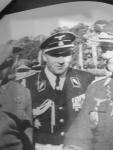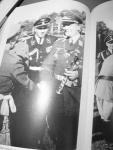
Panzerpionier
Active Contributor-
Posts
127 -
Joined
-
Last visited
Content Type
Profiles
Forums
Blogs
Gallery
Events
Store
Everything posted by Panzerpionier
-
The name of the pig was "Iolanthe", taken from a German comedy. Sometimes it can be found as "Jolanthe", just because German capital "I" and "J" look the same. The Stuka Kette (flight) was nicknamed "Iolanthe Kette". Best regards
-
Hello Mike I have some books that deal with Italian medals related to Spanish Civil war but I could not find yours, probably because it was a local award limited to "volunteers" from the city of Pisa. Best regards
-
That medal was created by the Spanish city of Ciudad Real for the Blue Division veterans. Therefore you can find the swastika, the arrows of the Falange party, the eagle of the official Blue Division medal and the crest of the city. Being a post-1939 item, that medal does not qualify as an Spanish Civil War item and is off-topic here. The ribbon should be red with two black and one yellow thin stripes.
-
That castle is the crest of the Spanish city of Ciudad Real: BTW the ribbon is wrong. Best regards
-
That item is not related in any way to neither the Condor Legion nor the Spanish Civil War.
-
According to the cross details, is a good one to me. The berries should disappear easily with normal use and wear, so they should be no an absolute rule. Best regards
-
As far as I know, that breast star was not awarded to LC personnel. Best regards
-
Have a look at these threads: http://gmic.co.uk/index.php?showtopic=1657 http://gmic.co.uk/index.php?showtopic=2193 http://gmic.co.uk/index.php?showtopic=994 http://gmic.co.uk/index.php?showtopic=1704 Best regards
-
That item is not related in any way to neither the Condor Legion nor the Spanish Civil War.
-
That item is not related in any way to neither the Condor Legion nor the Spanish Civil War.
-
That item is not related in any way to neither the Condor Legion nor the Spanish Civil War.
-
A book for the aircraft fans, but not for the "uniforms and badges" guys. Best regards
-
Be careful. A lot of the "colored pics" are actually WWII era, not SCW era. What is more, the cover pic was taken in the Russian front... Best regards
-
-
I finally got the pic. I had to take the pics with mi digital camera, as I have no scanner. Best regards
-
My friend Francisco is right. The Spanish term "Milicia" means both "Military profession" and "militia, irregular armed group of civilians". At the begining of the Spanish Civil War the republican side lacked true military units, as they disbanded the regular army in their territory. In order to fight the well organized, professional troops that composed the rebel (nationalist) side, a lot of militias were created. Most of them were related to political parties, and some of them were created in villages and towns. They were equipped with every gun they could get, including shotguns and old matchlock muskets (of low military value, of courtse!!!), but some of them received rifles from army depots. Most of the militia units were of very low military value, but some of them (usually created and controlled by Spanish Communist Party) fought well and could stop nationalist offensive towards Madrid. Those units were the foundations of the later "Ej?rcito Popular de la Republica" (People's Republican Army). Some militia units of parties different from the Communist Party refused to join the People's Republican Army, due to the heavy communist influence and control. On the other hand, during the History of Spain several different militias were created for different reasons. I think the doc found by Sal is not related to Spanish Civil War. Bes regards
-
The "Medalla de la Vieja Guardia": http://www.coleccionesmilitares.com/medall...exto/viejag.htm According to regulations: La Medalla ir? grabada por una sola cara que servir? de frente, dejando la otra para ser grabada sobre ella el nombre y los apellidos del concesionario, el n?mero del carnet que acredite su calidad de Vieja Guardia y el a?o de filiaci?n al Partido Translation: [...] The reverse shall be engraved with the name of the recipient, his party ID card number proofing his condition of "Old Fighter" and the year he joined the party. Best regards
-
My knowledge about Falange symbols is very limited, and I can not explain for sure the number on the back of the badge. On the other hand, bear in mind that Spaniards are not so "prone to regulations" as Germans. There as many different forms of Falange symbols as different manufacturers, because their dimensions and use were not regulated. Anybody who would want to show his support to the Falange movement could buy a yoke-and-arrows badge, and the size, shape and material was limited only by budget and personal taste. I know that the Falangist Medalla de la Vieja Guardia (Old Fighter Medal) was engraved with the recipient's name and party number, but in my humble opinion the number on Sal's badge could be the manufacturing lot. The Falangist movement started some years before the outbreak of the Spanish Civil War (1936) and there are some "nostalgics" that still belong to extreme-right political parties that claim to be the "true heirs of the Falange" and use its symbols, therefore is difficult to date the badge. Generally speaking, older badges are of much higher quality (some of them made in silver). The badges that are sold today in extreme-right shops are of very low quality. Best regards
-
In my humble opinion, just a Falange badge...
-
On top picture of page 122 of Bender's book you can see Johannes Bernhardt wearing the black Allgemeine-SS uniform. On his tunic pocket the Spanish Falange yoke-and-arrows badge is visible, and the Spanienkreuz w/o swords is barely visible under his dress aiguillettes. I know of a better picture of him, but I can not recall where I saw it. Best regards
-
As far as I know, some members of the French fascist organization "Croix de Feu" fought in the Nationalist side. They joined the Spanish Foreign Legion and were allowed to wear the French colors on his Spanish uniforms. Perhaps the Vichy government created an award for those anti-communist fighters. Best regards
-
That was the badge of the Nationalist Spanish fighter units during the Spanish Civil War. The Spanish Blue Squadrons used emblems in the Russian front that were variations of the original design, and some pilots who were veterans of the Spanish Civil war used the badge in his original form. This badge continues in use today in the Spanish Air Force by the unit who uses the Eurofighter. Some info on the badge (in Spanish): http://www.ctv.es/USERS/fnff/gmorato.htm http://www.aire.org/ea/historia/morato.htm http://www.chez.com/mirage3/salud_y_planchetas.htm In french, mon ami!!! AFAIK this was a Spanish badge and was not used by LC personnel. Best regards
-
Please note that I meant that KM personnel that served in Spanish waters and received either SK with or without swords were not entitled for ANY Spanish medal. Of course, some exceptions could happen, i.e. a KM ship rescueing Spanish Nationalist navy shipwrecked sailors and the like... in those cases probably the commander of the KM ship and some officers would receive the Spanish white naval cross. The KM personnel who served in Nationalist units were a different case and they received Spanish decorations. On the other hand, I have never seern a German ribbon bar with non-combatant Spanish Campaing medal (green borders). Best regards
-
First of all, KM personnel that served in Spanish waters received the SK without swords. On the other hand, according to SK regulations KM personnel that served in Spanish waters and were involved in some actions received the SK with swords: -Air raid on Ibiza (29th May, 1937) -Bombardment of Almeria (31st May, 1937). -Air bombing of Palma. The mentioned KM personnel was not considered "officially" as combatants by Spanish government, and they did not receive Spanish decorations. On the other hand, some KM members actually fought in the SCW as members of Nationalist units and therefore were eligible for both SK with swords and Spanish decorations: -Technicians, instructors and military advisors. One of them (Jurgen Jensen) was killed in the sinking of the Nationalist cruiser "Baleares". -AS/88 naval personnel, mainly observers. Naval observers were better than those from land-based units for ship recognition. Hope this help Best regards


